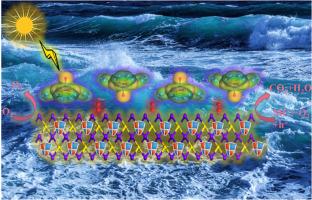开创性的 SubPc-Br/CdS S 型异质结:通过增强自由基协同作用和减缓光腐蚀实现卓越的光催化氧化作用
IF 11.2
1区 材料科学
Q1 MATERIALS SCIENCE, MULTIDISCIPLINARY
引用次数: 0
摘要
为了高效利用太阳能和减轻环境污染,半导体光催化技术的开发和应用至关重要。本文通过亚酞菁(SubPc-Br)和纳米硫化镉(CdS)的分子间π堆积自组装,合成了一种新型的S型异质结SubPc-Br/CdS超分子阵列。这种自组装体系具有高度结构化的架构和出色的稳定性。实验和基态微分电荷计算表明,亚酞菁和 CdS 在自组装过程中形成了内置电场,这是促进电子和空穴解离的关键因素。此外,本研究首次利用时变密度泛函理论(TDDFT)模拟了激发氧分子在 SubPc-Br/CdS 界面上的动态吸附行为。对不同激发态下分子电荷差密度的分析表明,SubPc-Br 分子的加入不仅提高了 CdS 在氧气吸附环境中的抗光腐蚀性,而且在 h+ 和 -O2- 的协同作用下增强了高级活性氧的产生。在可见光的作用下,米诺环素(MC)的降解效率在 60 分钟内达到 96.8%,5 个周期后保持在 80.3%。总之,这项研究强调了通过战略性地将有机超分子与半导体催化剂结合在一起来制造先进的 S 型异质结光催化剂的可行性。本文章由计算机程序翻译,如有差异,请以英文原文为准。

Pioneering SubPc-Br/CdS S-scheme heterojunctions: Achieving superior photocatalytic oxidation through enhanced radical synergy and photocorrosion mitigation
For the efficient harnessing of solar energy and mitigation of environmental pollution, the development and application of semiconductor photocatalysis technology is paramount. Herein, a novel SubPc-Br/CdS supramolecular array with an S-scheme heterojunction was synthesized through the intermolecular π-stacked self-assembly of subphthalocyanine (SubPc-Br) and nanometer cadmium sulfide (CdS). This self-assembly system features a highly structured architecture and excellent stability. Experiments and ground-state differential charge calculations demonstrate that SubPc-Br and CdS form a built-in electric field during the self-assembly process, a critical factor in promoting the dissociation of electrons and holes. Additionally, this study utilized time-dependent density functional theory (TDDFT) to simulate the dynamic adsorption behavior of excited oxygen molecules on the SubPc-Br/CdS interface for the first time. The analysis of molecular charge differential density under different excited states proved that the addition of SubPc-Br molecules not only improves the photocorrosion resistance of CdS in an O2 adsorption environment but also enhances the production of advanced reactive oxygen species under the synergistic action of h+ and ·O2–. When subjected to visible light, the degradation efficiency of minocycline (MC) achieved 96.8% within 60 min and maintained 80.3% after 5 cycles. In summary, this study highlights the feasibility of creating advanced S-scheme heterojunction photocatalysts through the strategic incorporation of organic supramolecules with semiconductor catalysts.
求助全文
通过发布文献求助,成功后即可免费获取论文全文。
去求助
来源期刊

Journal of Materials Science & Technology
工程技术-材料科学:综合
CiteScore
20.00
自引率
11.00%
发文量
995
审稿时长
13 days
期刊介绍:
Journal of Materials Science & Technology strives to promote global collaboration in the field of materials science and technology. It primarily publishes original research papers, invited review articles, letters, research notes, and summaries of scientific achievements. The journal covers a wide range of materials science and technology topics, including metallic materials, inorganic nonmetallic materials, and composite materials.
 求助内容:
求助内容: 应助结果提醒方式:
应助结果提醒方式:


